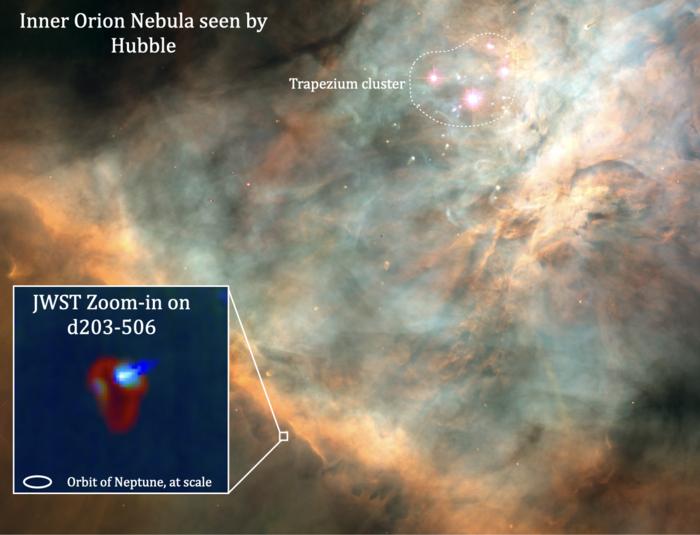Scientists discover radiation from massive stars shapes planetary systems
How does a planetary system like the Solar System come into being? To find out, CNRS scientists working as part of an international research team (1) studied a stellar nursery, the Orion Nebula, using the James Webb Space Telescope (2). By observing the nascent planetary system named “d203-506”, they discovered the crucial role of massive stars in the formation of nascent planetary systems (3).
Around 10 times more massive than the Sun, and above all 100,000 times more luminous, these stars project powerful ultraviolet radiation onto the surrounding planets. Depending on the mass of the star at the center of the planetary system, this radiation can both promote planet formation and destroy others by dissipating their matter. In the Orion Nebula, scientists observed that, due to the intense irradiation from massive stars, the planetary system “d203-506” could not form a planet like Jupiter.

To be published on the front cover of Science on March 1, this study reveals with unprecedented precision the decisive role played by massive stars in the sculpting of planetary systems. It paves the way for a new look at their genesis.
Notes
- The main French laboratories involved in this study are the Institut de Recherche en Astrophysique et Planétologie (CNES/CNRS/Université Toulouse Paul Sabatier), the Institut d’Astrophysique Spatiale (CNRS/Université Paris-Saclay), the Laboratoire d’Etudes du Rayonnement et de la Matière en Astrophysique et Atmosphères (CNRS/Université Cergy Paris/Observatoire de Paris-PSL/Sorbonne Université/), and the Institut des Sciences Moléculaires d’Orsay (CNRS/Université Paris Saclay). The study is part of the international project « PDRs4All ».
- Capable of piercing through dust veils, the James Webb Infrared Space Telescope enables us to observe distant stars such as the Orion Nebula, 1400 light-years from Earth.
- In other words, less than a million years old.
Further Resources
- Scientific Publication : A far-ultraviolet–driven photoevaporation flow observed in a protoplanetary disk by O. Berné et al., Science (2024), DOI: 10.1126/science.adh2861
- Press Review :
- « Spatial : le télescope James Webb révèle le rôle des étoiles massives dans la formation des planètes » (La Tribune)
IRAP Contact
- Olivier Berné, olivier.berne@irap.omp.eu






